Sources
Resources for Further Study
|
|
|
This page contains a list of references for learning more about the cactus family. If you are looking for sources to buy succulent plants, you
can find SucculentGuide.com approved suppliers through the NurseryLink application. Click here
to learn more.
For book purchases, visit: 
|
|
|
Aloes: The Definitive Guide
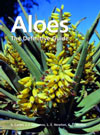
Susan Carter, et. al.
Purchase |
This is the "must have" book for Aloe lovers. It is the most comprehensive work on the genus since Reynolds 1966 book. The main thrust of this book is a
species by species account of all Aloes known as of 2008. Species described in 2009 and 2010 are included in an appendix with limited descriptions and some photos. Each species
is listed in an encyclopedia-like style with the name given as a heading. Detailed descriptions, notes on related or similar species, or other relevant data is also given as known.
Almost every species includes one or more photographs - mostly from habitat and illustrating the plant and flowers both. These accounts are divided into 10 groups based on
overall growth habit of the plant.
At the onset is an introduction to the genus as a whole and some cultivation text followed by a very extensive section on the history of Aloe exploration and discovery. This history section
could be a small book of its own at 73 pages and loaded with illustrations of people and plant art from the past.
One very specific thing not included in this book is a listing of nomenclatural synonyms either within the text or as an index in the back. Aside from this, criticism of the book
are few and this book will still prove useful to anyone who is even mildly serious about Aloes.
|
The Genus Echeveria
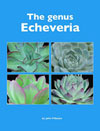
John Pilbeam
Purchase |
John Pilbeam is one of the greatest succulent plant authors in both the number of subjects covered and the quality layout of each publication. The Genus Echeveria is another
invaluable resource for the succulent grower by Pilbeam that lives up to his reputation. As typical of his fashion, this book gives an introduction to the genus, it
covers taxonomy and classification issues, and touches on dubious names or possible upcoming changes or additions in nomenclature. Additionally, there is a thorough description
of the geographic distribution of the plants along with color maps of the areas. The "heart" of the book is the detailed description of the various species. Each species
detail includes synonyms, describes the morphology of that species, and the specific distribution and habitat of each species. Most also include notes on cultivation, interesting
history for the given name or other observations of Pilbeam himself or those that he's gleaned from other sources. To top this off, there are almost 500 photos which illustrate stem
and inflorescence per species in brilliant detail. Indeed anyone who is interested in Echeveria, whether a novice or experienced grower will find themselves putting
this book to good use!
|
Didiereaceae
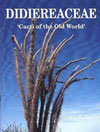
Gordon D. Rowley
Purchase |
This small 36 page booklet on the Didiereaceae is big on information. It is very well put together and
and excellent resource for anyone interested in these bizarre Madagascar endemics. This book discusses the natural habitat of the various genera and species
included in the family and gives a history of the discovery of these plants. Then a very helpful section discusses the morphology of the various plants and does a
nice job comparing and contrasting the various taxa which is very useful for identification. Following this is an encyclopedia-like description of each specific species. Finally,
a discussion on cultivation is included which mostly discusses growing in a European climate. Forty-five color photos are collected in the center and are mostly habitat plants. There are
also many line drawings with the text that help illustrate specific traits. This book is an exceptional value and will prove to be a sufficient reference for most anyone interested in the
Didiereaceae.
|
Glossary of Botanical Terms
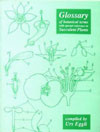
Urs Eggli
Purchase
|
This paperback book has 110 pages of botanical terms that any plant grower could benefit from, but it is especially handy for the
succulent enthusiast as it includes succulent-specific terms that are often left out of general botanic glossaries. While a keen
observer will note that there is an extensive glossary on SucculentGuide.com & CactiGuice.com, this book takes it to the next
level. Several line-drawings are included which prove helpful in explaining many of the terms.
|
Stapeliads
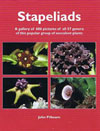
John Pilbeam
Purchase
|
The book Stapeliads, by John Pilbeam, is a bit different than his previous books. Those previous publications, such as Mammillaria, Ferocactus, and Echeveria
concentrated on a single genus of plants, while this book covers a total of 57 genera in the tribe Stapelia which are commonly referred to as "Stapeliads". As there are around
700 species in this group, detailed descriptions per species would not fit in a single book. This is evidenced by Peter Bruyns book on the
subject which covers only half the species and is a 2-volume set of over 600 pages! So in this case, Pilbeam primarily describes each of
the 57 genera and gives additional thoughts on classification or cultivation to varying degrees with each. After the description a list
of species is given and photographs of almost every species is included. Two pages at the beginning of the book give general cultivation
advice for this plant group. Throughout the book, Pilbeam is very careful to avoid taking a strong stance on classification and tried hard to
keep everyone happy. In total, this book is 207 pages and includes 686 color photos. It should prove a very handy reference for identification
and also as a species "checklist".
|
Pachyforms
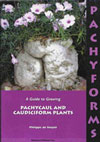
Philippe de Vosjoli
Purchase
|
Pachyforms could easily double as a "coffee table" book and a horticultural reference book. In the center of this
319 page soft-cover book are 163 pages of high-quality photos of caudiciform and pachycaul plants that are each a work of art. Sure to
capture the attention of those otherwise not interested in plants. Aside from all this eye-candy, there is a very large section on
the cultivation and care of these plants based on the authors many years of experience. This text is delightfully written and unlike
many growing instructions I've encountered, de Vosjoli writes as if he is speaking to the reader. This gives the book a personality and
really makes the reader want to continue reading. Some of the topics covered are watering, lighting, dormancy, and even plant-buying advice.
A discussion on what Pachyforms are and information on nomenclature are also included. Additionally, there are descriptions and advice
for many of the more common or most desirable species.
|
Pachyforms II
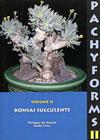
Philippe de Vosjoli
Rudy Lime
Purchase
|
Part two of Pachyforms is subtitled "Bonsai Succulents" as de Vosjoli has teamed up with Rudy Lime to present
a wonderful "how-to" book on growing succulent plants in the bonsai fashion. There is extensive coverage explaining all
of the necessary steps required for anyone willing to put in the effort to grow their own bonsai succulents. Written in a straight-forward,
easy-to-follow manner, the authors cover such topics as selecting plants, choosing the right pots, training plants, and on-going maintenance.
Following this well-illustrated, extensive guide are 135 pages of photos of many outstanding bonsai succulents. After this picture section, the
species descriptions continue from volume I and this is followed by another 120 pages of photos of various Pachycaul succulents. Like the
first volume, this second edition is loaded with practical information and a massive selection of photos making it excellent for
both "flipping through" and reading in depth.
|
Agaves, Yuccas, and Related Plants
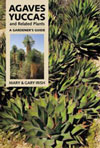
Mary Irish
Gary Irish
Purchase
|
This publication on those rosette-forming sword-like plants of North America is a handy reference for many of the most common species in the Agave plant family (including Nolinaceae which the
authors maintain independent of the Agavaceae). The various genera included are Agave, Yucca, Hesperaloe, Furcraea, Manfreda, Beschorneria, Polianthes, Nolina, Dasylirion, Beaucarnea,
and Calibanus. The book first discusses the plant families giving a history of the discovery and classification of each. Following this is a detailed description of the previously
mentioned genera. Continuing this trend, a section of species descriptions is also included. This is put together in a consistent format for each description with these sub-headings: synonyms,
size, leaves, bloom, distribution, propagation, cultural requirements, similar or related species, and uses. This format makes comparison of various species much easier than those publications
which mix the various attributes throughout the descriptions. Color photos are provided for each in two sections of "plates". While this is not as handy as including the pictures with
the text, the plate numbers make it easy to quickly find the corresponding pictures. There are over 100 photos in the plates and in other sections of the text, line-drawings illustrate various
features. There is also a fairly large section on the cultivation of the plants with frost tolerance data and ethnobotany among other things.
|
Hardy Succulents
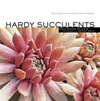
Gwen Kelaidis
Purchase
|
This 159 page book is well put together with lots of photos and illustrations throughout the text. Foundational discussions defining both succulence in plants and variables that
determine hardiness begin this book. The next 5 chapters of the book break down the various types of hardy succulents based on their relative size and/or intended
planting spots. These sections include "Tiny Gems" - discussing small plants, "Containers" -featuring outdoor pots and planters, "Succulent Ground Covers"
-relating to flat, mat-like plants, "Perennial Companions" - a mix of various hardy perennials, and "Shrublike Selections" - including those succulents that are shrub size or
even tree sized. The final chapter discusses planting methods, propagation, and on-going care of your hardy succulent garden. This book is a helpful starting point for those thinking about
adding some unexpected flair to their temperate-climate gardens.
|
Haworthia for the Collector
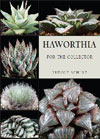
Rudolf Schulz
Purchase
|
Haworthia is a genus of small plants related to aloes and gasterias. The taxonomy of the group has proven to be very complicated and problematic.
Rudolf Schulz utilizes Bayer's 1999 revision of the genus while incorporating his subsequent revisions through 2008 as the basis for his excellent
book. Each Haworthia species and variety is illustrated with sharp color photographs, as are the most important cultivars and hybrids. In addition
to being a visual delight, the book is well written and informative, discussing the genus in general, Haworthia in the wild, Haworthia cultivation,
a summation of the taxonomic problems that have plagued the genus, as well as a useful synonym list. The book is not a botanical monograph or yet
another taxonomic revision; it is a book written for the collector, using the successful format Schulz has employed in other titles. This book is
a must for anyone interested in collecting and growing this fascinating group of plants.
|
Aeonium in Habitat and Cultivation
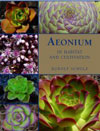
Rudolf Schulz
Purchase
|
Although Aeonium is a genus of succulent plants often disparaged by collectors, it is, as Rudolf Schulzís book demonstrates, a fascinating group of plants.
Most species are native to the Canary Islands, although there are a few species found in the Cape Verde Islands, Madeira, Morocco, and eastern Africa. The
book opens with a photographic species key, followed by a species-by-species look at each of the Canary Islands as well as the more far-flung
habitats. Schulz provides extensive information on each Aeonium species along with numerous photos of plants in the wild. The text also
offers a goldmine of information on popular cultivars, cultivation, as well as a synonym chart. This is the only comprehensive
volume available on the genus.
|
Lithops: Treasures of the Veld

Steven Hammer
Purchase
|
This is the second edition of Steven Hammer's successful Lithops: Treasures of the Veld (there is also a French edition), which was originally published in
1998 and long out of print. Written in Hammer's inimitable, entertaining style, the book offers a horticultural perspective on the genus. In addition to a general
introduction to plants in habitat, there is a good deal of practical information on pollination, raising Lithops from seed, and the cultivation of these curious
plants. Each species and variety, as well as numerous cultivars, is introduced and discussed by Hammer and illustrated with fine color photos by Chris
Barnhill. New to this edition is a section on species and cultivars that have appeared since 1998. This outstanding introduction to the genus Lithops and
its cultivation should not be missed.
|
Mesembs of the World
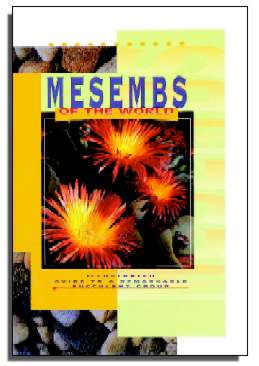
Multiple Authors
|
This book, co-authored by nine experts, provides an illustrated overview of 123 genera of the family Aizoaceae, popularly known as mesembs.
The authors break the family into fourteen categories based on growth pattern (i.e. flowering stones, tufted mesembs, mat-forming mesembs, and so on).
The genus descriptions include the etymology of the scientific binomial, common names, a genus description including distinguishing characteristics,
as well as notes on distribution, cultivation, and a species list. A distribution map accompanies each genus description along with sharp color photos
of representative or commonly encountered species. While some Aizoaceae genera are badly in need of revision, this volume provides an excellent overview
of the family as it is understood today. Despite the size and complexity of the family and the research that has been done since the book was published in
1998, this volume is still by far the best general introduction to mesembs available for the money.
|
|
| www.cactusexplorers.org.uk |
Free PDF Downloadable Cactus and Succulent Journal |
| Cactus & Co. |
Printed Journal in English and Italian and a very active web forum in Italian.
|
| www.cssainc.org |
The Cactus & Succulent Society of America -a must join organization for any serious Cacti/Succulent enthusiast |
| www.occss.org |
Orange County Cactus & Succulent Society -my local Orange County, CA club (See the CSSA site above for a list of local clubs near you) |
| Gene Schroeder's Images |
High-Quality photos of properly identified succulents in flower
|
| Cactus-Mall |
Cactus and Succulent website host and directory.
|
| Cactus-Aventures |
Quarterly journal on Cactus and Succulents in English, Spanish, and French.
|
| Piante Grasse |
Quarterly journal on Cactus and Succulents in both English and Itlaian versions.
|
| PlantZAfrica |
Highly-descriptive website highlighting many of the more popular plants of Southern Africa.
|
| Succulentseeds.com |
Over 5000 species of fresh cactus seeds, succulentseeds and other exotic seeds.
|
|
Success With Succulents
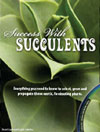
Panorama Studios |
Succulents are among the easiest plants to propagate and grow, and thus make excellent projects for both beginning and advanced gardeners. This DVD will show even beginners who have never grown a plant in their life how to easily and successfully grow succulents. They can be grown indoors or out, and will thrive in a wide range of outdoor climates.
|
|
|